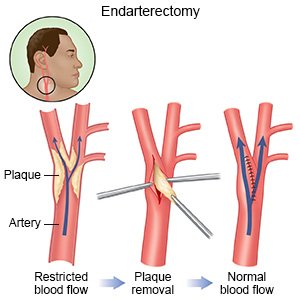Remote Superficial Femoral Artery Endarterectomy
Medically reviewed by Drugs.com. Last updated on Jun 2, 2025.
What do I need to know about remote superficial femoral artery endarterectomy (RSFAE)?
RSFAE is a procedure to remove plaque (fatty deposits) from inside your superficial femoral artery (SFA). The SFA is a large blood vessel found near your thigh. It supplies blood to your lower legs. Plaque may build up inside your SFA and decrease blood flow to your legs.
How do I prepare for the procedure?
- Your healthcare provider will tell you how to prepare. Your provider may tell you not to eat or drink anything after midnight on the day of your procedure. Arrange to have someone drive you home when you are discharged.
- Tell your provider about all medicines you currently take. Your provider will tell you if you need to stop any medicine for the procedure, and when to stop. Your provider will tell you which medicines to take or not take on the day of your procedure.
- Tell your provider about any allergies you have, including to anesthesia or contrast liquid. You may be given contrast liquid during the procedure to help your provider see your blood vessel better.
- Your provider will tell you if you need any tests before your procedure, and when to have them.
Drugs used to treat this and similar conditions
Crestor
Crestor (rosuvastatin) is used to treat high cholesterol and high triglycerides in the blood ...
Plavix
Plavix (clopidogrel) is used to prevent blood clots after a recent heart attack or stroke. Includes ...
Botox
Botox is used for cosmetic purposes and to treat overactive bladder symptoms, urinary incontinence ...
Tylenol
Tylenol is a pain reliever and a fever reducer used to treat many conditions such as headaches ...
Hydrocodone
Hydrocodone (Hysingla ER and Zohydro ER) is used for around-the-clock treatment of severe pain ...
Oxycodone
Oxycodone is an opioid analgesic used to treat moderate to severe pain; it has a high potential for ...
Paracetamol
Paracetamol (Panadol, Calpol, Alvedon) is a widely used over-the-counter painkiller and fever ...
Pentoxifylline
Pentoxifylline systemic is used for intermittent claudication
Ibuprofen
Ibuprofen (Advil, Motrin) treats minor aches and pains caused by the common cold, headaches ...
Gabapentin
Gabapentin is an anti-epileptic drug, also called an anticonvulsant. It is used to treat some types ...
What will happen during the procedure?
- You may be given general anesthesia to keep you asleep and free from pain during the procedure. You may instead be given local anesthesia to numb the procedure area. With local anesthesia, you may still feel pressure or pushing, but you should not feel any pain.
- Your healthcare provider will make an incision near your groin. Your provider will use fluoroscopy (continuous x-rays) to show the blocked or narrowed area of the artery. An incision will be made in the artery and a small tool will be inserted to remove the plaque. Your provider may place a stent (small mesh tube) into the artery to help keep it open.
- Your provider will remove the tool and close the incisions with sutures. A pressure bandage may be applied to your groin incision.
 |
What should I expect after the procedure?
- You will be taken to a recovery room until you are fully awake. Healthcare providers will monitor you for any problems.
- You may need to lie flat in bed and keep your leg straight for some time after the procedure. Do not get out of bed until your provider says it is okay.
- You may need to stay in the hospital overnight. You may instead be able to go home after the procedure.
What are the risks of RSFAE?
You may bleed more than expected or develop an infection. The stent may move out of place or the artery may become narrow again. You will need another procedure to fix this. You may develop a blood clot. Your artery may be damaged or weakened. This can cause a rupture. An artery rupture is life-threatening.
Care Agreement
You have the right to help plan your care. Learn about your health condition and how it may be treated. Discuss treatment options with your healthcare providers to decide what care you want to receive. You always have the right to refuse treatment. The above information is an educational aid only. It is not intended as medical advice for individual conditions or treatments. Talk to your doctor, nurse or pharmacist before following any medical regimen to see if it is safe and effective for you.© Copyright Merative 2025 Information is for End User's use only and may not be sold, redistributed or otherwise used for commercial purposes.
Further information
Always consult your healthcare provider to ensure the information displayed on this page applies to your personal circumstances.
